I've spent a couple of days redesigning this weblog (or rather, picking a great new template that someone else spent a couple of days on :-) It's not 100% ready yet, but most of it is up and running. So, hope you like it, I sure do :-)
Sticky notes is now Klang440, and can be found at www.klang440.org.
Feed can be found at http://feeds.feedburner.com/klang440.
You'll be redirected by the time you finished reading this. If you're really impatient, you can also click here.
Sunday, June 15, 2008
Sticky notes = Klang440
Thursday, June 5, 2008
Wednesday, June 4, 2008
HyperPhysics Concepts: Sound and hearing
Online click-through course about the physical aspects of sound and hearing.
Saturday, May 31, 2008
Historical gem
Concertgebouw orchestra playing Ouverture Oberon in 1937, under Willem Mengelberg.
Friday, May 30, 2008
San Francisco Symphony | Keeping Score: Revolutions in Music
Keeping Score: Revolutions in Music is a beautifully designed website that aims to make people more familiar with classical music. It is centered around four composers, Beethoven, Copland, Stravinsky and Tchaikovsky, and offers a lot of interactive possibilities to explore their lives, music, and, what I liked best: their scores. Take Rite of spring, for instance:
The main window displays the score, which automatically scrolls along with the music. It contains annotations and explanations that you can either display or hide. At the left part three subwindows show the orchestra playing, sketches from the ballet and information about meter and conducting. Clicking these takes you on yet more interactive tours, like 'Try your hand at conducting':
There's lot more to explore, but be warned: it's quite easy to forget time once you start browsing.
Sunday, May 25, 2008
Kettles and 40 world premieres in 40 minutes
Yesterday, the BMOL modern-classic-weird-baroque-cool concert-visiting gang (that’s me and three other percussion freaks) defied the Dutch railway system and managed to make our way to The Hague, to visit the Dag in de Branding festival, a one-day festival for contemporary music. The piece that made me decide to visit The Hague was Alvin Lucier's 'Kettles', for five timpani and two oscillators. Basically, the oscillators generated two pure sinusses that gradually diverge and converge. The interference that is caused by this, is mimicked by the timpani that are all tuned to a different ‘step’ (trap don’t know the English equivalent yet) within a major triad. While one timpani gradually accelarates (from one beat per 12 seconds to one beat per second), the other gradually slows down.
The piece that made me decide to visit The Hague was Alvin Lucier's 'Kettles', for five timpani and two oscillators. Basically, the oscillators generated two pure sinusses that gradually diverge and converge. The interference that is caused by this, is mimicked by the timpani that are all tuned to a different ‘step’ (trap don’t know the English equivalent yet) within a major triad. While one timpani gradually accelarates (from one beat per 12 seconds to one beat per second), the other gradually slows down.
The result was overwhelming: a wall of sound that was so massive and pervasive that there was no room left in my head to think. At some point, the pulses were so slow an weird that it almost felt like time itself being slowed down. The interference played all kind of tricks with our ears, sometimes sounding like a chopper close by, or like a drone in the back of your head, somewhere just below your skin. What a pity that it only lasted 13 minutes, I could have listened to it for hours.
The other works were worthwile too: two compositions by Lois Vierk (Yeah, Yeah, Yeah and Red Shift), one by Claudio Baroni (Incircles II), and a fascinating piece by Yannis Kyriakides, ‘Telegraphic’, where the six percussionists of Slagwerkgroep Den Haag were connected to players of Champ d’Action by means of six morse keys. Whenever the percussionists pressed their key, the sound of the corresponding player was amplified.
After that, we decided to skip the beach and go to a second concert: ‘Principles of Concision’ by Ensemble Klang. What a great decision: Klang asked 40 contemporary composers to write a short (max. 2 minute) musical signature that defined the essence of their work. In the words of one of the members: 'don't blink, or you might miss a piece'!
Composers to investigate: Lois Vierk, Heiner Goebbels, Tom Johnsson.
Saturday, May 24, 2008
Thursday, May 22, 2008
More timpani
Just returned from a concert at the Royal Concertgebouw where the RCO played Ouverture Euryanthe by von Weber, Schumann's Symphony No. 1, and Mussorgsky's Pictures at an Exhibition. What a night. My seat was on the stage, right next to the timpani, so basically I attended my second timpani clinic in one week. And who better to learn from than Nick Woud...I just hope I didn't stare too much :-)
With the timpani clinic in Ittervoort still fresh in my mind, I found that I knew much better what to look for tonight. Rather than just watching Mr. Woud play and sitting there in awe, I tried to focus on different aspects of his playing, like how a stroke was started and finished, the amplitude of the strokes, sticking, etc. One thing that struck me in particular (not literally of course) was the sense of purpose: every movement seemed to be there for a reason. From the very onset to the stroke to the end of it, it all just fit, nothing was superfluous.
Besides observing the timpani, I also had a great night just listening to the music of course. Pictures at an exhibition brings back so many childhood memories (no wonder: it's Smurf music! Gnomus and Tuileries were used in the Smurfs cartoon series). The only thing that disappointed me a bit, were the tempi, especially in Bydlo. I've got a wonderful recording by the RCO where you can really sense the cart approaching in the distance, very grave and quite oppressive. Tonight, I guess springtime got the better of the orchestra; I'd have liked it a bit slower.
Can't wait to try out some new things tomorrow!
Saturday, May 17, 2008
Visit to Adams - timpani mechanics
Just returned from a great day out at Adams in Ittervoort. Here's a report of a very educational and inspiring day (click on the pictures to enlarge them; click here to see all pictures of my visit).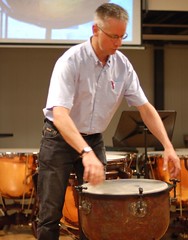
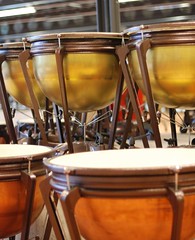
Timpani mechanics
Albert Straten started with a presentation about the mechanics of timpani, common problems that you might encounter, possible solutions and a step-by-step description of how to replace a timpani head. He also busted some popular myths about not turning the spring at the bottom, and explained how pedal tension and skin tension interact.
One thing to look for in Adams timpani, is the position of the spring in relation to the pedal rod: the screw at the end of the rod, the beginning of the spring housing and the end should be in the same horizontal plane (the angle doesn't matter, as long as its horizontal). Unfortunately, this only goes for Adams timpani. Ludwig uses another system, so I guess I need to convince my orchestra to either buy Adams, or send me off to Ludwig for a similar clinic, whichever is cheaper :-)
Factory tour
After that, we went for a tour through the woodworking place where keys for marimbas and xylophones are manufactured. It's a pity that we weren't allowed to take pictures, because the sights were amazing: crates and crates of rosewood left to dry, the fine tuner who manually tunes every key until it's spot on, chests full of keys... But the most memorable, without doubt, was the smell in the hall. No wonder that everybody there smiled all the time.
Next, we continued to the actual timpani factory. The views in there defy belief: everything is huge, and there's timpani bowls in every shape and state of manufacturing everywhere, along with loads of other percussion instruments. And one of the sweetest paradoxes: a company that presents new ideas and concepts that are so innovative that they have invented their own machinery; yet, when the company timpani tuner cannot attend because his car broke down, the company managing director comes down himself to demonstrate how to replace a timpani head.
After lunch, I took some photos in the showroom: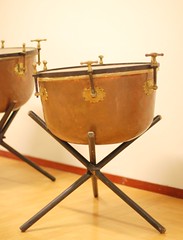
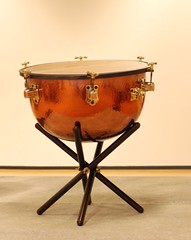

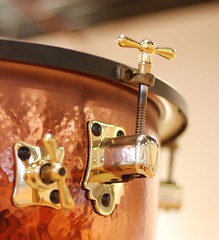
Spot the anomaly :-) The pictures on the left are genuine baroque timpani. Those on the right are modern Adams baroque timpani, built according to 18th century tradition, but with some 21th century benefits like a central tuning screw.
Visit to Adams - timpanic clinic by Werner Otten
After lunch, Werner Otten, principal timpanist of the Dutch Philharmonic Orchestra, took over with a timpani clinic.

Among the 40+ participants, two advanced music students were selected to play with Mr. Otten for about two hours, while the rest of us listened and learned - a lot!

Two technical learning points for me:
- When you play 3 ascending notes (on 3 timpani), try RRL. The other way round, when you play 3 descending notes, try LLR. This makes for a nice flow, and gives a sense of continuity.
- When you want to deepen and round the sound in a piano part, try hitting the skin at an angle (figure of eight), rather than hitting the skin in a straight vertical line.
Technique was one aspect of the clinic, but what I found most helpful was the great number of examples of different moods and characters that you can get out of timpani. Mr. Otten showed a lot of real-life examples from symphonic works, and what struck me is that he talked a lot about purpose, intention, phrasing, breathing and other concepts that I know from singing. Also, he showed a lot of 'just some strokes' vs. 'now this is making music' examples. Especially when he played piano parts, he produced sounds that were so un-timpani like, withdrawn, almost transparent.


At the end of the day, I left with a lot of new reference points and ideas for playing, plus a bag full of ridiculously cheap mallets.
Sunday, May 11, 2008
Meredith Monk
Somewhere back in 1994, when I still fit size 36, studied phonology and had a rather traditional musical backpack of classical choral and symphonic music, someone gave me two tapes, with the suggestion that, as a linguist, I might be interested in the "funny babbling" that interspersed the music. It was a copy of Atlas, an opera in three parts by Meredith Monk.
It would be too epic to say that that moment changed my life, but Monk's music did knock me off my feet the first time I listened to it. It was unlike anything I'd heard so far, both musically and emotionally. The tape was a copy, Internet not yet widely available, so I had no idea what I was listening to, apart from the idea of traditional opera (which it didn't remotely resembe) and the evocative song titles like "Personal Climate - Future Quest", "Desert tango", and my favorite piece "Agricultural Community", which was my first encounter with asymmetric rhythm.
So, quite unprepared, I suddenly found myself in a world of whooping, screaming, yodling, sighing, crying, whispering, moaning, stammering and talking voices. Really, imagine anything possible with a voice, add anything you deem impossible, and that's what Meredith Monk is about. And there's nothing artificial about it, it's all so natural, so obvious, that you can't help thinking that this is what singing is about, should be about: setting the voice free to do its own thing, to express its owner's own personality, emotion, doubt. 
As she says herself: "I work in between the cracks, where the voice starts dancing, where the body starts singing, where theatre becomes cinema".
What attracted me even more, is that there seemed to be a phonology-like system underlying Monk's choice of soundscapes. I don't know whether she did this deliberately, but many of the sound sequences make maximum use of the structural oppositions in, for instance, the vowel diagram (juxtaposing /e/ with /o/, /i/ with /u/). Also, the choice of whether to use words or sounds, seemed to be related to the sincerity of the message that was conveyed - words somehow sounding more insincere than the ecstatic voices set free in their own domain. Of course, one could argue that this is almost inevitable, but still, it added extra interest (and hours spent phonologically analysing her music) for me.
After the first surprise, the tapes travelled along with me, surviving five boyfriends, three rounds of moving house, my transition from student to career woman; and somehow, they kept surfacing at those important moments in my life. I'd play them, and still find new things. Until they finally gave out, and I decided to buy a proper, legal CD-box. And read the accompanying booklet. And found out that what happened to me and my tapes, was exactly what the opera was about.
Back in 2006, I had the opportunity to see and hear Meredith Monk in Hamburg, a very memorable experience. I still remember her entering the stage: tiny, but incredibly powerful. She started to sing Wa-lie-oh; after the first few notes, about half the people in my row got up and left. After the second song, some more, but those who stayed, almost tore the roof down. I'm not sure whether it was my mind playing tricks, but it was almost like there were lights and colours around her on the black backdrop everytime she started singing, it was that intense.
After the concert, I did something quite un-Maaike like: I posted at the back entrance. Then walked away, telling myself not to act so adolescent. Then returned and waited some more, until she came out. I spent quite a while talking to her about her music, the effect it had on the audience that night. And I got to thank her for, well, basically, what I just wrote down. Very special indeed.
I've included quite a lot of Monk songs in my Last.fm playlist in the right sidebar. On Ubuweb, there's a documentary on Meredith Monk and her work. Here's the first part:
Friday, May 9, 2008
The European Timpani - MA Project by Scott Weatherson
Scott Weatherson, a former student of the Amsterdam Conservatory of Music, has researched why European timpanists use the instruments they do, which factors influenced their choice of instrument, mallets and skins etc. To that end, he compiled a questionnaire and sent it to 13 European timpanists.
The result is a comprehensive description of the timpani, timpani mechanics, its history; the quotes by the actual players give a nice insight not only in their musical expertise, but also in their personalities; as Michael Vladar shows when he comments on playing pieces that were written with pedal timpani in mind on machine timpani:
I play the Concerto for Orchestra of Bartók on them : I must pay then a percussionist an eighth of wine, so that he turns the handle for me during glissandi. Otherwise one can play everything on them.
Thursday, May 8, 2008
Musilanguage model
For the more scientifically inclined: the article by Steven Brown where he proposes and elaborates on the musilanguage model.
Abstract:
Analysis of the phrase structure and phonological properties of musical and linguistic utterances suggests that music and language evolved from a common ancestor, something I refer to as the “musilanguage” stage. In this view, the many structural features shared between music and language are the result of their emergence from a joint evolutionary precursor rather than from fortuitous parallelism or from one function begetting the other.
Music and language are seen as reciprocal specializations of a dual-natured referential emotive communicative precursor, whereby music emphasizes sound as emotive meaning and language emphasizes sound as referential meaning. The musilanguage stage must have at least three properties for it to qualify as both a precursor and scaffold for the evolution of music and language: lexical tone, combinatorial phrase formation, and expressive phrasing mechanisms.
Sunday, May 4, 2008
On the origin of music and language
Found a preview of the book How Music REALLY Works!, Chapter 1: What Music REALLY Is, Who Makes It, Where, When, Why, which deals with the origin of music, and a possible joint origin of music and language. Easily accessible, but quite informative. There's five other chapters availabe online.
An excerpt from chapter 1:
Language syntax (order or arrangement) and musical syntax appear to share common processes in the brain. Studies of brain activity during music and language processing show similarities in the way the brain handles temporal (time-related) aspects of both language and music. “When we listen to language and music, not only do we expect words or chords with specific meaning and function, but we also expect them to be presented on time!”
Music could have evolved from speech, or speech from music, or, more likely, both speech and music could have co-evolved, sharing a common ancestor that had some characteristics of speech, some of music. In early humans, the music-language precursor, termed “musilanguage” by the neuroscientist Steven Brown, would have conveyed referential meaning (i.e., information) and also emotional meaning, using discrete pitch levels and expressive phrasing.Eventually, the musilanguage precursor would have split into two specialties:
- A specialty for conveying mainly referential meaning symbolically, (language), initially by expressive phrasing, and later using a vocabulary of words
- A specialty for conveying emotional meaning, mainly without symbolic meaning (music), via discrete pitch levels.
Music and language likely co-evolved, and therefore interacted.
Saturday, May 3, 2008
Varese: Ionisation
And an interesting background article by Dutch percussionist Niels Le Large about Varese and his importance for percussion as an independent musical entity.
Wednesday, April 30, 2008
Alvin Lucier - Music for Piano with One or More Snare Drums (1990)
Came across another interesting composer today: Alvin Lucier. His Kettles, a piece for five timpani and two oscillators, is performed at the 'Dag in de Branding' festival by Slagwerkgroep Den Haag on May 24.
I couldn't find a recording of that particular piece yet, but I found this one: Music for Piano with One or More Snare Drums, a very quiet and meditative piece where the snares are resonating along with the piano.
Apparently, he has written something for 'enormously amplified brainwaves'. WTF?
More info on his albums here.
Tuesday, April 29, 2008
Druschetzky: Concerto for Oboe, Eight Timpani and Orchestra
Funny isn't it, the things you remember, and the things you forget. Somewhere back in secondary school music class, I took a test with the question: "Which percussion instrument zou eventueel gebruikt kunnen worden to play a melody?" The italic part roughly translates as might in some cases be usable. Puzzled by the phrasing, I answered "timpani". Surely, a tunable drum could in some cases be used for melodic purposes? As long as you had enough of them!
It got marked incorrect. The teacher, appropriately called Mr. Sedee, the Dutch pronunciation for CD, insisted that timpani weren't remotely usable for playing melodies; the only correct answer was a mallet instrument, and preferrably xylophone.
I can still remember how indignant I felt at the gross injustice of this. No matter how I tried to explain that a mallet instrument is always used for melodies, not eventueel, and that timpani had definite pitch, he wouldn't budge.
This memory resurfaced when I found this early 18th century timpani concerto by Georg Druschetzky.
Mr. Sedee, eat your heart out :-)
Sunday, April 27, 2008
Kraft - Timpani concerto
Randy Max
Oscar Salazar
Daniel Kirkpatrick
Yearly 'Leerlingenconcert' - to hell with sheet music
Last night at the yearly pupil concert, I played Announcement, a piece for snare, tom, cymbal and timpani. The timpani part is such fun to play; it's the only part that sounds remotely melodic, and it really gives a great drive to the rest of the piece.
But somewhere in the middle, there's a muffle, a pitch change and a roll, within the space of one beat. Rather a bit of a challenge for a beginner like me. I've practised this point so much, that my sheet music was covered in red notes on how to fit everything in the right place. I guess that having to cram so many comments into one beat left me with the idea that I had no time at all: the more I wrote down, the less I managed to actually play the part :-)
But then, last night, something really great happened: a second before we started playing, realisation hit me that I didn't need any of this. The piece was already there somewhere; I just needed to step out of the way and let it get out. And that gave me all the time in the world, time to look around, time to listen, and best: time to really enjoy myself!
Tuesday, April 22, 2008
Carter, Stravinsky, Goehr
As heard in the Concertgebouw this night:
E. Carter - Asko Concerto
Stravinsky - Movements
E. Carter - In the Distances of Sleep
A. Goehr - Little Symphony
E. Carter - Dialogues
I don't know what it is with Carter: I love his timpani pieces, but when I listen to other stuff, it gets on my nerves. Not because I don't like it, but rather because I don't know how to approach it. It's not music that goes straight to my heart or my stomach, but that doesn't mean that it doesn't touch me. I left feeling disturbed, disconcerted and even indignant, like someone did something really upsetting to me.
I suspect he's doing this on purpose. Just look at the way he grinned at me from the program notes all night:
Thursday, April 17, 2008
Prokoviev - Fifth symphony
As heard in Utrecht, played by Bellitoni, an amateur orchestra from the Hague.
Tuesday, April 8, 2008
David Hockings - percussionist or timpanist?
Part of the wonderful Soundjunction website, David Hockings takes us through a wonderfully illustrated explanation of the difference between timpanists and percussionists.
Here's another example from the website. Another cool feature is that it offers many different ways to access the information that's there; you can either browse the information like on any regular website, but in addition, Soundjunction offers various learning trails that provide a structured guide through over 60 different themes, like 'The classical orchestra', 'Ideas for composing' and 'Music and the brain'.
Educational, entertaining and informative: why aren't there more websites like these?
Sunday, April 6, 2008
Steve Reich - Piano phase (excerpt)
Went to listen to the marimba version of this piece last night in the Concertgebouw. Players: Wim de Vos and Peppie Wiersma. Cool detail: Peppie Wiersma played 'Curves' by Ron Ford, a piece for theremin. Cypher is currently building one; great to hear it live!
Friday, April 4, 2008
The Well Tempered Timpani
The Well Tempered Timpani gives a technical, but really interesting overview of the acoustic properties of timpani.
Contrary to wind and string instruments (and the voice), resonating membranes do not have a harmonic overtone series. In addition, the fundamental is not very resonant or pleasant-sounding. This is caused by the acoustic properties of a membrane: rather than vibrating in just one direction, a membrane can vibrate in various modes simultaneously. Most of these modes are non-harmonic.
Still, it's possible to get pitch and near-harmonic overtones from a timpano. This is possible mainly due to air loading: columns of air above and below the air that make the membrane act almost as if it's a single vibrating system. This has been the subject of various studies, some of which are discussed in this article.
Monday, March 31, 2008
Volcano music



Holiday on Tenerife made me wonder what a volcano sounds like. It's different from a mountain- it's not green, no yodeling going on, no hunters sounding their horns. Hardly anything lives there, hardly anything sounds there. It's rock in every imaginable colour: from deep black to red, yellow and even soapy green. The clouds roll over the crater rim in an eerie silence. Yet, there's an immense sense of energy hidden just below the surface, waiting to happen.
Music-wise, I wondered whether anyone had ever written anything specifically on volcanoes. A Google-search pointed me to Alan Hovhaness, an American composer who composed a symphony on the eruption of Mount St Helens.
And what do you know: volcanoes themselves make music too. At least, according to Italian researchers who plotted seismic activity of Mt. Etna and Tungurahua (Equador) to music bars.
Friday, March 14, 2008
Yamaha timpani manual
Yamaha timpani manual with cute warnings like
Disregarding these warnings or misuse may result in death or personal injury and
Do not use the mallet for anything besides playing the instrument. Do not allow children strike others with the mallet.
(Glad I'm not a child anymore, apparently adults can do with the mallet whatever they like :-)
Wednesday, March 12, 2008
Paukenclinics 2008 - Adams Muziekcentrale
Yay! Adams organises Paukenclinics 2008: a tour around their factory, a short workshop on how to change timpani heads, and a workshop by Werner Otten, timpani tutor at the Maastricht Conservatory of Music. I gave them a call to enquire whether complete newbies like me could attend, and received a hearty reply to please do so.
So, May 17th, I'm waking up in the middle of the night to make my way south to Ittervoort!
Tuesday, March 11, 2008
Matthew Bassett
Personal website of Matthew Bassett with a nice practice guide and a promise to include articles and essays.
Monday, March 10, 2008
Mini booklet with timpani basics
Taken from A Fresh Approach Video Lessons with Mark Wessels: a mini booklet with timpani basics.

